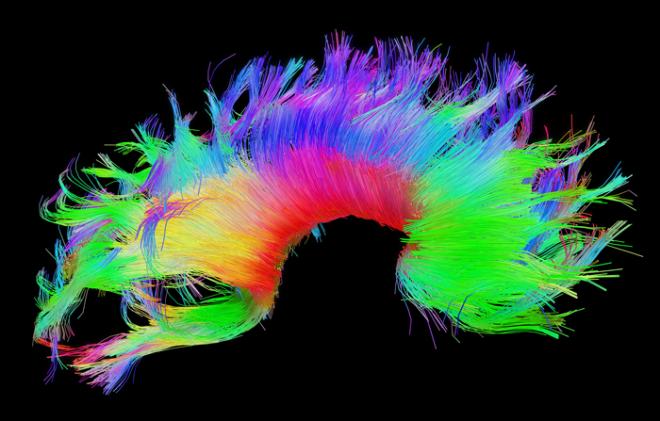
Figure 1. Human Connectome Project. Bottom angle of the corpus callosum connecting the left and right hemispheres of the brain. Project Photo, 2015.
Introduction
For this weeks seminar we will be discussing Biomedia and Communication, through Mitchell and Hansen’s essays in Critical Terms for Media Studies (2011) and through artworks from the last 80 years in Edward Shanken’s Art and Electronic Media (2010).
In my seminar presentation I will outline some of the definitions stated in Mitchell and Hansen’s texts. I will highlight aspects of Biomedia through Eugene Thacker’s The Science Fiction of Technoscience: The Politics of Simulation and a Challenge for New Media Art (2001). I will pose several questions, workshop ideas with the class and we will discuss our findings.
What is Biomedia?
What is all the fuss about Biomedia? What is reductionism? What do these terms actually mean? Sifting through this weeks readings I came across a few gems to help us along the garden path, so to speak. Firstly, Eugene Thacker in his chapter Biomedia in Critical Terms for Media Studies suggests that:
“[B]iological life can be approached as technical, open to being designed and engineered at the molecular or genetic level. And Information is increasingly seen as having vital properties of its own, a capacity to adept, evolve, and mutate” (CTMS, 2010, pg. 117).
Thacker further outlines Biotechnology as being integrated into society in many ways. Specifically Biotechnology:
“[E]xtends to the artifact, tools, and techniques that populate the life science research lab: genome sequencing computers and gene-finding software, online genome and proteome databases, silicon chips arrays with DNA fragments, and even labs on a chip” (CTMS, 2010, pg. 117-118).
He defines Biomedia as “the ability to create conditions in which biological life itself is understood as being informational and yet not necessarily immaterial” (CTMS, 2010, pg. 124). He also states that the “relationship between biology and information, life and code, is at the centre of the biomedia concept” (CTMS, 2010, 122-123).
“Biomedia entail the information recontextualization of biological components and processes, for ends that may be medical or non medical, and with effects that are much cultural, social, and political as they are scientific” (CTMS, 2010, pg. 123).
Here Thacker suggests that Biomedia can be many things such as DNA or acts like sequencing. His points seem to revolve around the notion that “Biomedia depend upon an understanding of biology as informational but not material” (CTMS, 2010, pg. 123).
Writer Nicholas Ruiz sheds light on Thacker’s (Thacker, 2004) term, suggesting that:
“The substance of biomedia is the instantiation of the posthuman narrative evinced by the technological recontextualization of the human being, particularly at the level of the concept, resulting in the new and radical version of human biology, and of the biological components of which it is comprised (e.g. proteins, DNA, RNA, etc.) — another level of anthropomorphosis, to be sure” (Ruiz, Reconstruction, Web).
These ideas are particularly relevant in regards to our recent seminar conversations on the Body, Senses and Time + Space. Thacker in his Biomedia, suggests that we have pushed our bodies to the limit countless times over the millennia. We are more than just our bodies, and our increasing awareness and acceptance of our flesh is translating into emergent simulations of what we could be. Debra Regis describes this process as a meaningful acceptance:
“Where a historical moment ago, the flesh was once evil, and the soul divine, we have come to the point at which we now lie prostrate to the Flesh, and the form or physique of its malleable mold; the soul seems a little lost in all of this process of becoming bodies — and most recently, globalizing mediated bodies. The soul is lost, and for some, perhaps tout est foutu. But that needn’t be the case. It is true, in spite of ideals, that the law of the milieu must vary, as the terrain expands for some and rescinds for Others, even if “(we) do not know how to forget” and even if “archiving and anamnesis, those two well-springs of piety and its practices, cannot emerge intact from our consignments to machines” (Regis, 2004, pg. 235).
Regis’s ideas run parallel to Donna Haraway’s notions of “vibrant human actors” in her Cyborg Manifesto (Haraway, 1991). In Haraway’s text she argues for the cyborg as both a product of social reality and fictionalized narratives. Haraway further describes the cyborg as possessing agency, political relations – with a capacity to defy consciousness, time and space. Her ideas resonate with where we as a western culture find ourselves today: are we cyborgs, hybrids, mosaics, or chimeras? Biomedia “present us with a unique instance in which biological life itself is at once the tool and the object, the product and the production process” (CTMS, 2010, 127). The fruit of what Eugene Thacker is trying to feed us is revealed in these two statements:
- Biomedia is life working upon life.
- Biology and technology are inseparable.
I would like us to use these ideas to guide us through our discussion.
Body, Brain and Technology
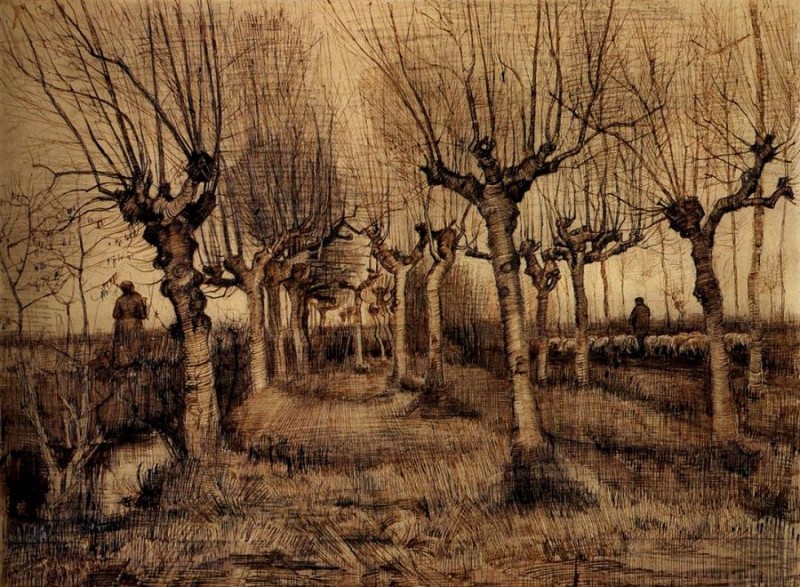
Figure 2. Pollard Birches, Vincent van Gogh, 1885.
“The senses are effects of the nervous system, composed of hundreds of billions of neurons extending from the body surfaces through the spinal cord, to the brain. The brain, it must be said, yields to philosophical reflection a sense of the uncanny” (Buck-Morss, 1992, pg. 11).
Author Susan Buck-Morss in her Aesthetics and Anaesthetics: Walter Benjamin’s Artwork Essay Reconsidered (1992), describes how the “brain is not an isolable anatomical body, but part of a system (see Fig. 2) that passes through the person and her or his (culturally specific, historically transient) environment” (Buck-Morss, 1992, pg. 12).


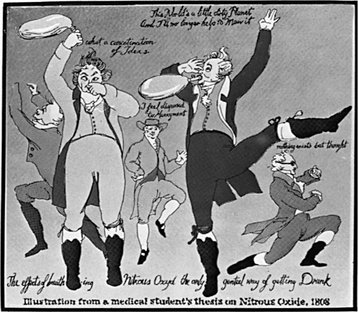
Figure 3-5. Caricature of Nitrous oxide (ether) frolics, 1808.
“Ether frolics,” the nineteenth-century version of glue- sniffing, was a party game, in which “laughing gas” (nitrous oxide) was inhaled, producing “voluptuous sensations,” “dazzling visible impressions,” “a sense of tangible extension highly pleasurable in every limb,” “entrancing visions,” “a world of new sensations,” a new “universe composed of impressions, ideas, pleasures, and pain” (Buck-Morss, 1992, pg. 21).
Here Susan Buck-Morss outlines how middle class people were dealing with pain and ailments (see Fig. 3-5). She describes that it wasn’t until the mid-century that the practical implications for surgery were developed (Buck-Morss, 1992, pg. 21). She states further that “discoveries in germ theory and antiseptics transformed the operating room from theatrical stage into a tile-and-marble, scrubbed-down, sterilized environment” (Buck-Morss, 1992, pg. 32).
She discusses further the implications of technology into daily life practices:
“Technology as a tool and a weapon extends human power-at the same time intensifying the vulnerability of what Benjamin called the tiny, fragile human body (Buck-Morss, 1992, pg. 33).
Here she describes how we perhaps use technology as a protective shield, where one sees oneself as “a physical body divorced from sensory vulnerability” or perhaps “a statistical body; a performing body; a virtual body, one that can endure the shocks of modernity without pain” (Buck-Morss, 1992, pg. 33).
Buck-Morse’s ideas are a good jumping point to discuss how we are becoming more Biomedia oriented as a society.
Human Genome Project
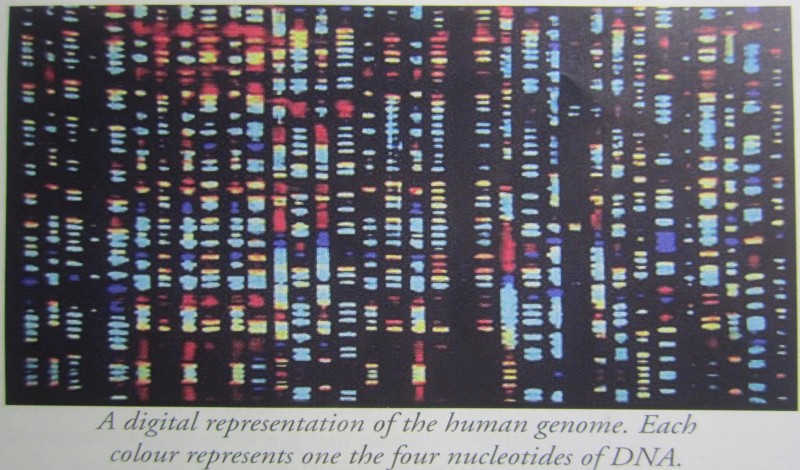
Figure 6. Human Genome Project, 2009.
According to the government website, The Human Genome Project (HGP) was one of the great feats of exploration in history (HGP, Website).
“[A]n inward voyage of discovery rather than an outward exploration of the planet or the cosmos; an international research effort to sequence and map all of the genes – together known as the genome – of members of our species, Homo sapiens. Completed in April 2003, the HGP gave us the ability, for the first time, to read nature’s complete genetic blueprint for building a human being” (see Fig. 6),(HGP, Website).

Figure 7. Human Genome Project, 2005.
The Human Genome Project was a publicly funded, 13-year-long project, initiated in 1990. The goal of the project was to determine the DNA sequence of the entire euchromatic human genome (see Fig. 7) within 15 years. Conversely the rough draft of the genome was finished by 2000, after widespread international cooperation and advances in computer technology and sequencing.

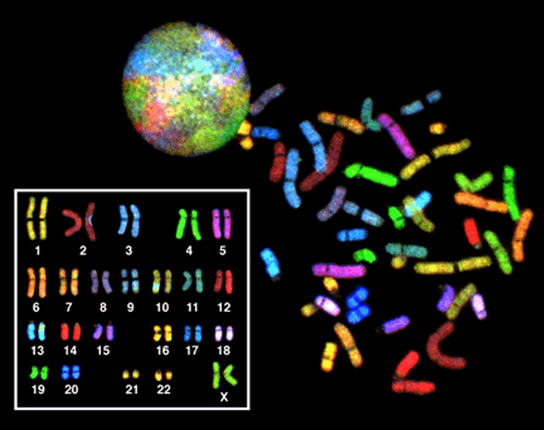
Figure 8-9. Human Genome Project, 2003. Found Images.
Images of the genome bear striking resemblances to the work of pioneer electronic artists (see Fig. 8-9) such as Ben Laposky’s Oscillation #4 (1956), James Whitney’s Yantra (1950-7), Stan Vanderbeek and Kenneth Knowlton’s Poem Field No. 2: Life Like (1967), and Lillian Schwartz and Kenneth Knowlton’s Pixillation (1971), (AEM, 2010, pg. 79-86).
The artworks listed has also impacted media studies because they “bring together technology, culture and biology in unique ways” (CTMS, 2010, pg. 126). And more importantly, Thacker states that Biomedia:
“[P]resent a view not merely of biological life as information, but of biological life that is life precisely because it is information” (CTMS, 2010, pg. 126).
Human Connectome Project
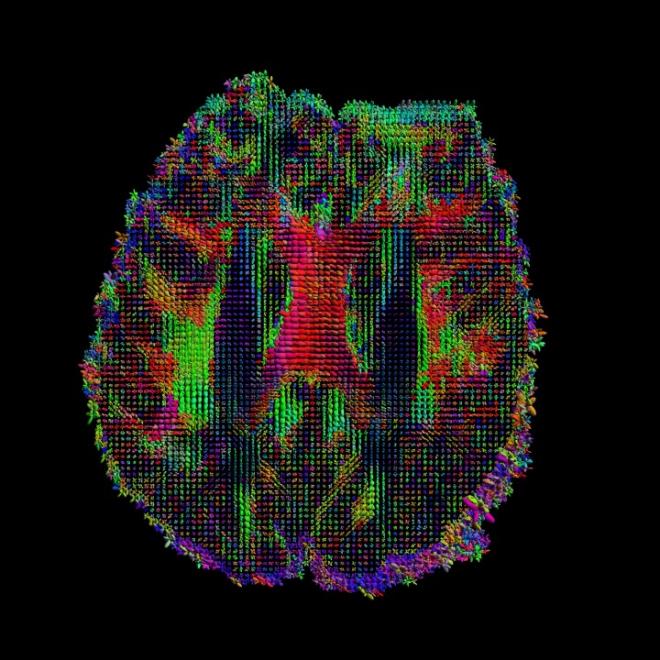
Figure 10. Human Connectome Project. Visualized in 3D space, the brain shows fluid mappings and brain connectivity. Human Connectome Project Photo, 2015.
The Human Connectome Project (HCP), is a venture funded by the National Institutes of Health. The goal is to create a map of the circuitry within the human brain (HCP, website).
Human Longevity and Oceans
Figure 11a + 11b. Craig Venter, 2015. The Health Nucleus, Promo Video.
After Craig Venter left the Human Genome Project he researched our oceans, drawing samples etc (see Fig. 11a). His latest project is the Human Longevity (HLI), aimed at trying to create the world’s largest and most comprehensive database of whole genome, phenotype and clinical data (see Fig. 11b). His website pitch states that they will provide “a novel approach devoted to exploring, quantifying and beginning to understand as much as possible about individual health and disease risk” (The Health Nucleus, Website).
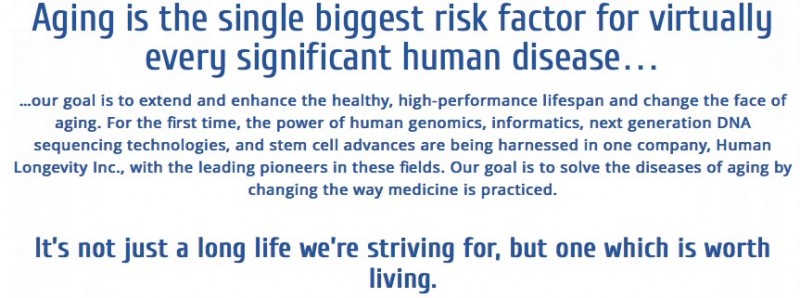
Figure 12. The Health Nucleus, Website.
What is interesting about Venter’s research teams approach is that they focus on genomics-based technology to understand individual assessments using large scale computing and machine learning to “make novel discoveries to revolutionize the practice of medicine” (The Health Nucleus, Website).
Dolly

Figure 13. Dolly and her Lamb Bonnie, 1997. Roslin Institute Photo.
In 1996 Scottish scientists cloned Dolly the sheep from a mammary cell taken from a Finnish Dorset sheep by nuclear transfer (see Fig. 13 + 14). Her life span was shorter than other sheep and her DNA may have been more susceptible to premature aging.
I include Venter, and Dolly in this conversation as examples of vitalism. Vitalism means that “living organisms are different from non-living entities because they contain non-physical elements/ governed by different principles than are inanimate things” (Bechtel and Richardson, 1998, Web).
Eugene Thacker asks a set of questions at the end of his chapter. We will also discuss these in depth in response to the course readings.
- Can life be reduced to a set of mechanical, mathematical, or material principles?
- What is the difference between the living and the nonliving, the biological and the technological?
- How is the future the human (the “posthuman”) to be situated?
Figure 14. The Story of Dolly the Cloned Sheep, 2013. The New York Times Video.
Conclusion
Considering these ideas and biological, self-organizing structures, we will watch Heather Barnett’s discussion on Slime Mold (2014). Slime Mold is an incredible microorganism that lives in cool, moist areas.


Figure 15-16. Lycogala Epidendrum, 2015.
Figure 17. Slime Mold, 2015. FrancisCheeFilms.
This video shows a time-lapse of Slime Mold. Of particular interest is that Slime Molds are NOT related to Fungi (see my post on Fungi, Trees) (see Fig. 15-16) although originally classified within this group. Over the last few years they are now classified under Amoebazoa.
Figure 18. Heather Barnett, 2014. Talk on Slime Mold (physarum polycephalum microorganisms).
Barnett brings up some interesting perspectives on what people can learn from the semi-intelligent slime mold in our contemporary techno-evolving society (see Fig. 18). Lastly, the research that her and colleagues do at the Slime Mold Collective is of particular relevance for this weeks discussions.
Works Cited
Barnett, Heather. What Humans Can Learn From Semi-Intelligent Slime, 2014. TedTalk.
BECHTEL, WILLIAM and ROBERT C. RICHARDSON (1998). Vitalism. In E. Craig (Ed.), Routledge Encyclopedia of Philosophy. London: Routledge.
Buck-Morss, Susan. “Aesthetics and Anaesthetics: Walter Benjamin’s Artwork Essay Reconsidered.” October 62 (1992): 3-41.
Chee, Frances. Slime Mold, FrancisCheeFilms. 2015.
Mitchell, WJ Thomas, and Mark BN Hansen, eds. Critical terms for media studies. University of Chicago Press, 2010.
Regis Debray, God: An Itinerary, New York: Verso (2004), p235.
Shanken, Edward A. “Art and Electronic Media.” (2009).
Thacker, Eugene. “Biomedia.” Minneapolis, MN: University of Minnesota Press, 2004.
Thacker, Eugene. “The Science fiction of Technoscience: The Politics of Simulation and a Challenge for New Media Art.” Leonardo 34.2 (2001): 155-158.
The Story of Dolly the Cloned Sheep, 2013. The New York Times Video.
Venture, Craig. The Health Nucleus, Website, 2015.
Add yours Comments – 5
Following up on our discussions last week on Biomedia, I came across another artist that is fusing technology/body into artworks.
For example in Francois-Joseph Lapointe’s Microbial Selfie, he connects his biological research with performance art. His latest works of art deal with the microbiome in our daily lives and physical connections to others. Lapointe sequences his microbiome to produce metagenomic self-portraits, Microbiome Selfies, which illustrate the metamorphosis of his bacterial self. The final images visualise the microbial change from interacting with someone else’s microbiome – by shaking hands, a basic and ancient act of networking.
Tools: In order to generate this data visualization, samples of his oral and gut microbiome have been sequenced on a MiSeq platform by means of 16S rRNA targeted amplicon sequencing, and the resulting data have been analyzed using QIIME, an open-source bioinformatics pipeline for performing microbiome analysis. The gene similarity network was produced with the open graph viz platform Gephi, using the Fruchterman–Reinhold algorithm (Lapointe, Press Release).
Press Release
I came across this beautiful website. Specifically, of interest to our discussions is the physarum they have growing in the glass vessel.
An interesting interview with Jurij Krpan on the ethical issues in art that engage with biotechnology and living organisms: http://creativedisturbance.org/podcast/confronting-vegetal-otherness-skotopoiesis-as-seen-by-the-curator-meeting-with-jurij-krpan-eng/
Saša Spacal together with Mirjan Švagelj and Anil Podgornik are also interested in the contrast between the oneness of the human body as biological entity and the multiplicity of the human microbiome. In their installation Mycophone_unison the collective has developed a sound map of intra-action between their microbiomes and the recipient. The work involves an audience member giving a fingerprint that then sends a signal to the map that processes it through the central celestial plate to the microbiomes. The polymodal sonification stresses the multiplicities of the makers (Spacial, Švagelj and Podgornik , Press Release).
These are great examples and they trace quite a meme. I was looking up microbiotic self-portraits too, in works by Gary Schneider and Edgar Lissel.
Francois-Joseph Lapointe’s network representations are great. Thank you for pointing them out. I remember reading that at the evolutionary scale of bacteria, the notion of species begins to unravel. They are too mutable,
exchanging and updating their DNA (bacterial conjugation). And so what matters more than individual species are the sets of genes encoded by all of them.
One more thing I just read today… There is a recent theory about bacteria communicating through radio waves:
http://www.wired.com/2011/04/bacterial-radio/